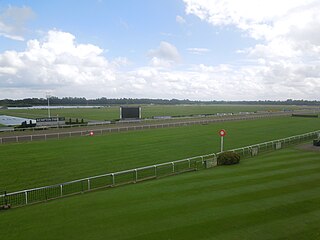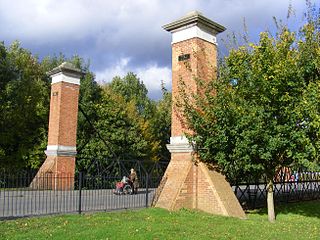
Aintree Racecourse is a racecourse in Aintree, Metropolitan Borough of Sefton, Merseyside, England, bordering the city of Liverpool. The racecourse is the venue for the Grand National steeplechase, which takes place annually in April over three days. Aintree also holds meetings in May and June, October (Sunday), November and December.
Leicester Racecourse is a horse racing course in Oadby, Leicestershire, about three miles south of the city centre.

Cheltenham Racecourse at Prestbury Park, near Cheltenham, Gloucestershire, England, hosts National Hunt horse racing. Racing at Cheltenham took place in 1815, but comprised only minor flat races on Nottingham Hill. The first racing on Cleeve Hill was on Tuesday 25 August 1818 when the opening race was won by Miss Tidmarsh, owned by Mr E Jones. It was a year later when the results were printed in the Racing Calendar when a programme of flat racing was watched by the Duke of Gloucester who donated 100 Guineas to the prize fund. By 1831 races were being staged at Prestbury, although not on the present day course. In 1834 the Grand Annual Steeplechase was run for the first time. In 1839 Lottery won the Grand Annual having previously won the first Aintree Grand National. In 1840 the meeting transferred to Andoversford for a brief period, only to return to Prestbury in 1847. 1902 was a notable year in that racing moved to the present course at Prestbury Park. The new stands were completed in 1914 and the present day Festival races, as we know them, began to take shape. The Cheltenham Gold Cup, over 3 ¼ miles, was run for the first time in 1924, with the Champion Hurdle following in 1927.

Kempton Park Racecourse is a horse racing track together with a licensed entertainment and conference venue in Sunbury-on-Thames, Surrey, England, near the border with Greater London; it is 16 miles south-west of Charing Cross in central London. The site has 210 acres of flat grassland surrounded by woodland with two lakes in its centre. Its entrance borders Kempton Park railway station which was created for racegoers on a branch line from London Waterloo, via Clapham Junction.

Ayr Racecourse at Whitletts Road, Ayr, Scotland, was opened in 1907. There are courses for flat and for National Hunt racing.

Hurst Park Racecourse was a racecourse at Moulsey Hurst, West Molesey, Surrey, near the River Thames. It was first laid out in 1890 and held its last race in 1962.
Chepstow Racecourse is a thoroughbred horse racing course located just north of the town of Chepstow in Monmouthshire, Wales, near the southern end of the Wye Valley and close to the border with England. It is one of 16 racecourses operated by the Arena Racing Company and is home of the richest race in Wales, the Coral Welsh Grand National.
Newton Abbot Racecourse is a thoroughbred horse racing venue located on the north bank of the River Teign in the parishes of Kingsteignton and Teigngrace just north of Newton Abbot, Devon, England. The course is a tight, flat left-handed oval of about 1 mile 1 furlong. There are seven relatively easy fences to a circuit and a very short run in to the finish.

Perth Racecourse is a thoroughbred horse racing venue adjacent to the ancient Scone Palace, near Perth, Scotland.
Ripon Racecourse is a thoroughbred horse racing venue located in Ripon, North Yorkshire, England and is nicknamed the Garden Racecourse.
Sedgefield Racecourse is an English left-handed horse racing course, used for jump racing. It is owned by Arena Racing Company and located close to the town of Sedgefield, County Durham.

Worcester Racecourse is a thoroughbred horse racing venue located in the city of Worcester, Worcestershire, England. Horse racing has taken place here since at least 1718. It staged Flat racing until 1966 but has since staged National Hunt racing only.

Lincoln Racecourse is a former horse racing venue to the west of the city of Lincoln, at Carholme, a flat tract of common land, Lincolnshire, England. It was the original location of the Lincolnshire Handicap. The course closed in 1964, and the following year the race relocated to Doncaster Racecourse where a small change to the race title sees it run as the Lincoln Handicap.

Bromford Bridge Racecourse was a racecourse in the Bromford area of Birmingham, England. Its official name was 'Birmingham'. It staged flat and national hunt racing.
Cork Racecourse, also known as Cork Racecourse Mallow, is a horse racing venue at Mallow, County Cork, Ireland which stages both National Hunt racing and Flat racing. It is located 35 km north of Cork and 64 km from Limerick

Alexandra Park Racecourse, known to Londoners as Ally Pally, was a horse racing venue in Alexandra Park, London; it was colloquially known as the Frying Pan on account of its shape. It opened on 30 June 1868 and closed 102 years later on 8 September 1970. It is now incorporated into the park, with a sports pitch in the centre of the racetrack oval.

Stockton Racecourse, also known as Teesside Park, was a British horse racing venue near Stockton-on-Tees in the north east of England, once considered "the finest in the north". Although named "Stockton Racecourse" there has never been a racecourse within Stockton-on-Tees, these courses were actually located across the River Tees in the North Riding of Yorkshire". Pre 1830s an alteration called the Mandale Cut of the river Tees was made. This caused the land of the racecourse north of the Tees to therefore became North Yorkshire. Due to the memory of the land being north of the Tees when the course was named it became Stockton Racecourse.

Lanark Racecourse was a Scottish horse racing venue, situated in the small town of Lanark in Scotland's Central Belt, 25 miles (40 km) from Glasgow. It was reputedly founded by King William the Lion of Scotland (1165-1214).
Rothbury Racecourse was a horse racing venue in Northumberland, England which closed in 1965. It was situated just outside the village of Rothbury, on a plain by the River Coquet.














